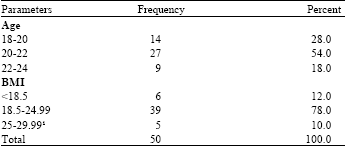Research Article
Body Weight Changes During the Menstrual Cycle among University Students in Ahvaz, Iran
Department of Biostatics and Epidemiology, Faculty of Public Health, Jundishapur University of Medical Sciences, Ahvaz, Iran
Majid Karandish
Nutrition and Metabolic Diseases Research Center, Department of Nutrition, Jundishapur University of Medical Sciences, Ahvaz, Iran
Mahdiye Ghoreishi
Nutrition and Metabolic Diseases Research Center, Department of Nutrition, Jundishapur University of Medical Sciences, Ahvaz, Iran
Farshad Soroor
Nutrition and Metabolic Diseases Research Center, Department of Nutrition, Jundishapur University of Medical Sciences, Ahvaz, Iran
Fatemeh Shirani
Nutrition and Metabolic Diseases Research Center, Department of Nutrition, Jundishapur University of Medical Sciences, Ahvaz, Iran










